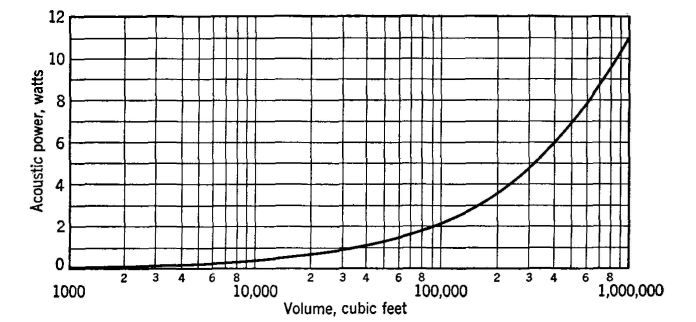| Electrical Communication is a free textbook on the basics of communication technology. See the editorial for more information.... |

|

Home  Fundamentals of Acoustics Fundamentals of Acoustics  Acoustics of Studios Acoustics of Studios |
|||






|
|||
Acoustics of StudiosAs indicated in Fig. 4, the reverberation time should be lower for studios than for auditoriums. It is advisable to design a studio so that the reverberation time will be correct over a frequency range from about 30 to 10,000 cycles. Such calculations necessitate a knowledge of the desirable reverberation time15,16,17 and also a knowledge of the sound-absorbing qualities of the various acoustic and building materials over this frequency band.
Certain complex and intangible subjective effects such as tonal "brilliance," "brightness", and "liveness" must be considered in the design of broadcast and sound-recording studios.15,16,17,18 Studios have been designed with "live" ends and "dead" ends. The live end contains little sound-absorbing material, and the musicians usually occupy this portion, so that the proper blending of the musical sounds is attained. The microphone is placed in the dead end, which is provided with much sound-absorbing material so that little reflection occurs. The modern tendency is not to concentrate the sound-absorbing material at a given area, but to spread it more or less throughout the room. Certain surfaces are often constructed of convex plywood "cylinders." These have absorbing properties at certain frequencies and also tend to vibrate and enhance certain frequencies.17 Also, curved and non-parallel surfaces tend to prevent multiple reflection of certain frequencies from surface to surface that might result in "flutter." Studios are usually approximately rectangular with the provision, previously mentioned, that the surfaces are broken up with convex surfaces, or in other ways. To prevent the transmission of vibrations, and the entrance of sound from outside sources, studios are usually "floated" so that they are effectively isolated from the rest of the build-ing.5, 10 Air ducts for heating and ventilating must be carefully designed so that they do not convey sounds into the studio.
|
|||
Home  Fundamentals of Acoustics Fundamentals of Acoustics  Acoustics of Studios Acoustics of Studios |
|||
Last Update: 2011-05-30


